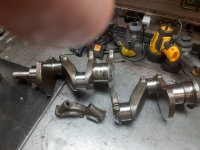Offline
A good friend called up with the news that his Tr4 had broken a crank. Pretty fresh build, but he does some AutoCross
and hits 6000 fairly often. Stock rods , it is proved once again, are CRAP !! Have you ever weighed a stock rod??
Save you the trouble 930gr +- 6gr. It may as well be a brick. Modern steel rods have ARP bolts and now cost less than
the expense of reconditioning old rods.They weigh 660gr, Even if math is a swear word to you, this is a LOT lighter.
(nearly 10 oz) The loads imposed on a 60 year old crankshaft by this extra mass at high RPM is measured in TONS!!
I say that the only place for stock rods, at this point in history, is the scrap pile! If you build a motor and fail to invest
in the good stuff it a mistake. All of our LBC"s are old enough to need all the TLC they can get.
My buddy now has to try and save his block which will involve line boring (new main center cap) and a full build from there.
Seems like just the other day(2 years ago), I said "ya need steel rods dude" He is getting them now.......
Mad dog
and hits 6000 fairly often. Stock rods , it is proved once again, are CRAP !! Have you ever weighed a stock rod??
Save you the trouble 930gr +- 6gr. It may as well be a brick. Modern steel rods have ARP bolts and now cost less than
the expense of reconditioning old rods.They weigh 660gr, Even if math is a swear word to you, this is a LOT lighter.
(nearly 10 oz) The loads imposed on a 60 year old crankshaft by this extra mass at high RPM is measured in TONS!!
I say that the only place for stock rods, at this point in history, is the scrap pile! If you build a motor and fail to invest
in the good stuff it a mistake. All of our LBC"s are old enough to need all the TLC they can get.
My buddy now has to try and save his block which will involve line boring (new main center cap) and a full build from there.
Seems like just the other day(2 years ago), I said "ya need steel rods dude" He is getting them now.......
Mad dog

 Hey there Guest!
Hey there Guest!
 smilie in place of the real @
smilie in place of the real @
 Pretty Please - add it to our Events forum(s) and add to the calendar! >>
Pretty Please - add it to our Events forum(s) and add to the calendar! >> 




 A friendly reminder - be careful what links you click on here. If a link is posted by someone you don't know, or the URL looks fishy, DON'T CLICK. Spammers sometimes post links that lead to sites that can infect your computer, so be mindful what you click.
A friendly reminder - be careful what links you click on here. If a link is posted by someone you don't know, or the URL looks fishy, DON'T CLICK. Spammers sometimes post links that lead to sites that can infect your computer, so be mindful what you click.